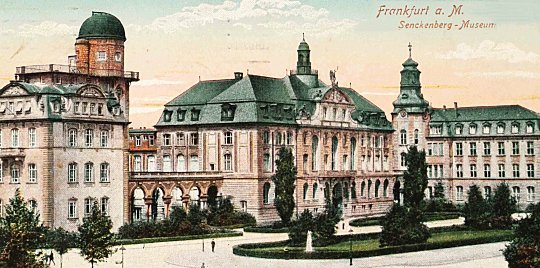Biology - History of the collection since the 18th century

18th and 19th century: The foundation of a library
The history of the Biology Collection dates back to the 18th century. The Frankfurt doctor, founder and naturalist Johann Christian Senckenberg (1707-1772) established the Dr. Senckenbergian Foundation (Dr. Senckenbergische Stiftung) during his lifetime. As its purpose he determined the promotion of the health care system in Frankfurt as well as the maintenance and the development of a scientific library. He bequeathed his private library, which contained nearly 10,000 volumes, including many works of biology and the descriptive natural sciences, to the foundation. In the following decades, the library experienced considerable growth through gifts and bequests of local physicians and naturalists (among others the botanist Johann Jacob Reichard).
From 1850, after library mergers involving several scientific institutions (Senckenberg Natural History Society, Medical Institute, Physical Association, Medical Association, Association for Geography and Statistics), the official name was Senckenbergische Bibliothek (Senckenbergian Library). Already at this time there were agreements with the Municipal Library on the acquisition profile, according to which the Senckenbergian Library covered natural history and medicine. Of utmost importance for the further development of the library (continuing up to the present time) was the international exchange of publications operated by the Senckenberg Natural History Society. The publications received in exchange, predominantly biological literature, have been provided by the Society as long-term loans to the Library (and are still provided as such).
1907 - 1947: A central library for the biological sciences
In 1907, the Senckenbergian Library with its rich collections of biological literature moved into a new building
in the Viktoria-Allee (today Senckenberganlage), next to the also newly built natural history museum
(today "Naturmuseum Senckenberg "). Over the next two decades, which were marked by significant financial difficulties
for the library, the exchange of descriptive science journals, especially in biology, contributed significantly to
a continuous growth of holdings. In the middle of the 1920s about one third of all journal titles held at that time
in the Senckenbergian Library were classified as pure biology; another third were natural history journals with
significant proportions of biological content.
To exploit the potential even better, the Notgemeinschaft der deutschen Wissenschaft (1929 renamed the Deutsche
Gemeinschaft zur Erhaltung und Förderung der Forschung, or German Community for the Maintenance and Promotion of
Research) from 1928 on promoted the exchange of publications. The goal was to make Frankfurt the "library center
of Germany for the descriptive natural sciences" (Rauschenberger 1933).
During the Second World War, the holdings of the Senckenbergian Library were largely preserved thanks to evacuation.
Collection
- More about the collection profile
- History 1948-2014
- History since the 18th century
- Catalogues and tools
- Library use
Zurück zum Seitenanfang
zuletzt geändert am 15. Oktober 2024
